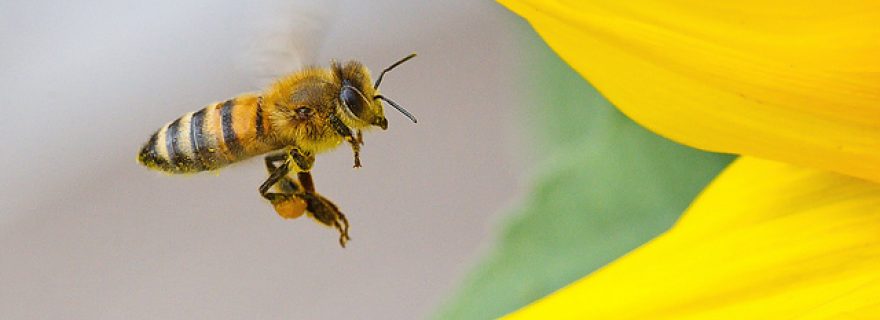The Emotional Bee: Honey Badgers, Cocaine and Dancing Bees
Honeybees exhibit behaviors that could be interpreted as negative emotions. Does that mean that insects have emotions? And what does it mean that cocaine makes bees dance more?
Does the family dog know what it means to be depressed? What about that sadistic mosquito that keeps you awake all night, is it actually enjoying pestering you? These might be questions usually reserved for Buddhists or animal-lovers – but research is starting to show us that even tiny invertebrates like bees elicit behaviors that might be interpreted as emotions. The question then is: should we believe that animals experience emotions and what does that mean for our interactions with and understanding of them?
A recent study by Bateson, Desire, Gartside and Wright (2011) showed that if you scare bees, they exhibit what is called a negative cognitive bias. Basically, the bees were pessimistic about whether they would receive a reward. Now you are probably asking: how in Darwin’s beard did they manage to “scare” bees, let alone tell whether they were being pessimistic?
We cannot ask animals how they feel, so we have to observe how they act and then infer what they are feeling. Bateson et al. (2011) first taught a group of bees that one smell resulted in them receiving sugar and another smell resulted in a bitter substance called quinine. If you are a bee, you prefer the first smell and consider the bitter-tasting substance punishment. Bateson et al. (2011) then shook one group of bees to simulate an attack of e.g. a honey badger (Believe me, honey badgers are scary! Don’t believe me? Well check this video of a honey badger getting bitten by a cobra, passing out only to wake up and finish eating the cobra). A control group was left unshaken. The researchers then once again presented different smells to the bees. They presented the smell associated with sugar, the smell associated with bitterness and smells that ranged in between the two. They observed that the scared bees would not experiment with the ambiguous smells as much as the control group, but still remained “optimistic” about the sugar-related smell.
According to Bateson et al. (2011) this shows that the bees create a negative cognitive bias following stress. This might seem like stretching it a bit but it actually makes a lot of sense for bees (and most animals) to become pessimistic about rewards in a stressful situation. When looking at the evolutionary roots of decision-making it makes sense to consider the The Smoke Detector Principle, which states that the most adaptive response to a possibly dangerous and ambiguous stimuli is to be defensive (Marks & Nesse, 1994).
So if the bee is feeling threatened, it will play it’s cards safe and not experiment, since the cost of being cautious is a lot lower than the risk of being eaten. Seeing that there is an adaptive evolutionary basis for this negative cognitive bias it makes it a good measure of cognition across species (Bateson et al., 2011). What Bateson et al. (2011) also found was that the bees had lower levels of the neurotransmitter dopamine. In bees dopamine deals with learning related to both reward and punishment (Waddell, 2010; Wright et al., 2010).
So bees can become pessimistic if you frighten them. But is it possible to make them optimistic – to create a positive cognitive bias? Yes – if you feed them cocaine. This is exactly what Barron, Maleszka, Helliwell and Robinson (2009) did. Bees can convey where a food source is located and how valuable it is through a series of specific “dances”. Barron et al. (2009) fed cocaine to honeybees and observed that cocaine-influenced bees systematically overestimated the value of the food source they had found compared to a sober control group. You might say that they just moved more because they were fed a stimulant, but the bees only danced more in socially appropriate situations (Barron et al., 2009).
This coincides with what we mentioned earlier about the role of dopamine. Cocaine disrupts the bees’ dopaminergic system (Barron et al., 2009), which is involved in both reward and punishment. It therefore also seems possible to achieve a positive cognitive bias in which bees overestimate the reward and act optimistic.
We have now seen bees exhibit a negative cognitive bias when stressed and a positive cognitive bias when exposed to cocaine in two different experiments. The question then remains whether or not bees experience emotions. As Bateson et al. (2011) concludes: none of these findings lets us say anything about the Umwelt, the subjective experience of what it is to be like to be a bee, or what emotions they might be feeling, but it calls into question how we identify emotions in non-human animals and which implications this might have both at a practical animal welfare level but also on a more biological and philosophical level of understanding the (animal) world around us.
References:
Barron, A., Maleszka, R., Helliwell, P., & Robinson, G. (2009). Effects of cocaine on honey bee dance behaviour. Journal of Experimental Biology, 212, 163-168.
Bateson, M., Desire, S., Gartside, S., & Wright, G. (2011). Agitated Honeybees Exhibit Pessimistic Cognitive Biases. Current Biology, 1070-1073.
Marks, I., & Nesse, R. (1994). Fear and fitness: An evolutionary analysis of anxiety disorders. Ethology and Sociobiology, 15, 247-261.
Waddell, S. (2010). Dopamine reveals neural circuit mechanisms of fly memory. Trends in Neurosciences, 33, 457-464.
Wright, G., Kottcamp, S., & Thomson, M. (2008). Generalization Mediates Sensitivity to Complex Odor Features in the Honeybee. PLoS ONE, 3.
Wright, G., Mustard, J., Simcock, N., Ross-Taylor, A., Mcnicholas, L., Popescu, A., & Marion-Poll, F. (2010). Parallel Reinforcement Pathways for Conditioned Food Aversions in the Honeybee. Current Biology, 20, 2234-2240.


0 Comments